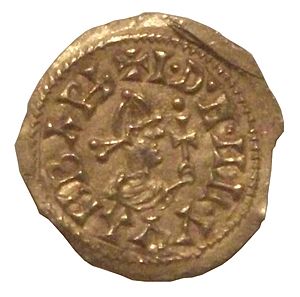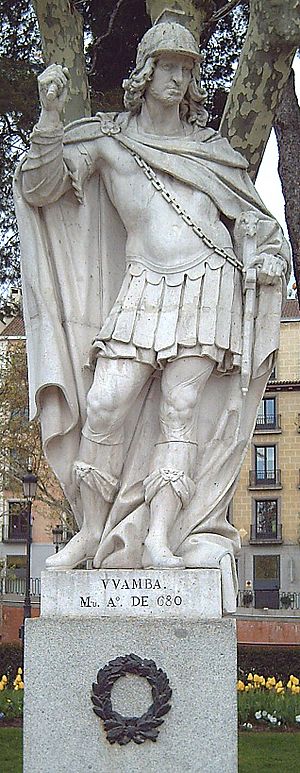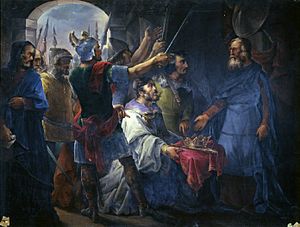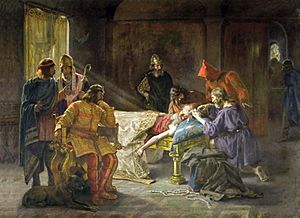Wamba (king) facts for kids
Quick facts for kids Wamba |
|
|---|---|

Coin of Wamba bearing his effigy
|
|
| King of the Visigoths | |
| Reign | 1 September 672 – 14 October 680 |
| Predecessor | Recceswinth |
| Successor | Erwig |
| Born | c. 643 Visigothic Kingdom |
| Died | 687/688 (aged 43–45) Visigothic Kingdom |
Wamba (born around 643, died 687/688) was a powerful king of the Visigoths. He ruled from 672 to 680. During his time as king, the Visigothic kingdom was very large. It included all of what is now Spain and a part of southern France called Septimania.
The name Wamba might have meant "big paunch" in the old Gothic language. This is similar to the German word "Wampe." It could have been a nickname for him.
Contents
King Wamba's Reign
Military Challenges

When Wamba became king on September 1, 672, he immediately faced a big problem. A governor named Hilderic, who was in charge of Nîmes, started a rebellion. Hilderic wanted to be king himself.
Wamba sent his general, Paul, to stop the rebels. But when Paul arrived in Narbonne, he decided to join the rebellion! He convinced his soldiers to make him king instead of Wamba. Other leaders also joined Paul, and many cities in France and northeastern Spain sided with him. Paul even got many soldiers from the Franks and Basques to help him.
At this time, King Wamba was fighting against the Basques in another part of his kingdom. When he heard about Paul's rebellion, he quickly marched his army to the Tarraconensis region. In just a few days, he got most of the cities there to support him again.
Wamba then divided his army into three groups. They attacked over the Pyrenees mountains. They captured important places like Collioure and Llívia. They found a lot of gold and silver there.
As Wamba's army moved towards Narbonne, Paul put General Wittimer in charge of the city. Paul himself went to Nîmes. Wamba's forces quickly took Narbonne. After some fighting, they also captured Nîmes on September 3, 673. Paul and the other rebel leaders gave up. They were punished by having their heads shaved and were sent to prison for life. Shaving their heads meant they could no longer be leaders.
After this big rebellion, the kingdom had a time of peace. In 674, Wamba rebuilt the old Roman walls around Toledo. He also made other places stronger, possibly a village called Hondarribia. Wamba also brought the Astures and Ruccones people under his control. These groups had been fighting for their freedom for a long time.
Later, the kingdom faced attacks from Saracen raiders. Some old writings say that many Saracen ships attacked the coast of Spain during Wamba's time. However, other sources don't mention such a large attack.
Wamba made new laws to help protect his kingdom. One law said that everyone, no matter their religion or if they were priests, had to defend the kingdom if it was attacked. He made this law because many people would run away when enemies invaded. Another law said that slaves could be set free if they joined the army. This shows that the king needed more soldiers to protect his land.
Religious Gatherings
In 675, an important church meeting called the Third Council of Braga was held. This meeting made eight new rules about church practices.
In the same year, another big meeting, the Eleventh Council of Toledo, took place in November. King Wamba wanted to make some changes in the church. He tried to set up a new type of monastery in a place called Aquis. However, other church leaders did not agree with his plan.
How Wamba Left the Throne
In 680, Wamba became very ill. Some stories say he was poisoned. He was given a special religious ceremony for people who are about to die. Because of this ceremony, he had to step down as king when he got better.
Some people blamed Wamba's successor, Erwig, for this event. Others thought it might have been Julian of Toledo, a church leader who later became very powerful under Erwig. However, Julian of Toledo also wrote a book that helped keep Wamba's memory alive.
Legends of King Wamba
Wamba's Birthplace
There are different stories about where Wamba was born. One tradition says he was born in a place called Egitânia, which is now Idanha-a-Velha in Portugal. Another Spanish story says he was born in Galicia. Some old family records suggest he was from a royal family but was very poor, maybe because his father lost his power when Wamba was young.
The most famous story says he lived in a village called Pujerra in southern Spain. The ruins of an old mill are nearby, and some believe this was close to his actual birthplace.
Becoming King

There are at least two famous legends about how Wamba became king.
One legend says that Wamba's father, who was also a king, had two sons born secretly in a hidden village. When the time came to choose a new king, soldiers were sent to find these sons. They found a young man named Wamba who was looking after cattle with a stick. The soldiers told him he was the new king. Wamba didn't want to be king. He stuck his wooden stick into the ground and said, "I will only accept the throne if this stick takes root." The stick was from a black poplar tree, which grows easily. When it started to grow leaves, Wamba agreed to become king. He was chosen and crowned in a small village that is now called Wamba, near Madrid.
Another legend tells a similar story, but Wamba is an old man. After King Recceswinth died, the Visigothic leaders needed to choose a new king. They decided on Wamba, who was known as a good man but had always refused important jobs.
A holy man named Saint Leo told them that God wanted a farmer named Wamba to be king. So, messengers found Wamba working in his fields. They told him, "Leave your plow! You have been chosen as king of Spain!" Wamba replied, "There is no better work than farming. Find another king. I prefer to rule my fields."
The messengers begged him. Finally, Wamba said, "I will accept the crown when the dry stick in my hand turns green again." He pushed the stick into the ground, and everyone watched in amazement as it suddenly grew green leaves. Everyone believed this was a sign from heaven.
Even then, Wamba tried to refuse the throne. But one of the Visigothic leaders pulled out his sword and threatened Wamba if he didn't accept. So, Wamba finally agreed.
This legend of the stick growing is also connected to the town of Guimarães in Portugal. People say Wamba never took the stick out of the ground there, and it grew into an olive tree. Even though the tree is gone now, the place is marked by a church and a town square named after the legendary tree.
Saint Giles and the King
A story from the 10th century tells about King Wamba and a holy man named Saint Giles. One day, King Wamba was hunting a deer in a forest. The deer ran into a cave where Giles, a hermit, was praying. Wamba shot an arrow into the cave, but he accidentally hit Giles instead of the deer. Giles was wounded in the leg and was always lame after that.
When Wamba found out what he had done, he was very sorry. He offered Giles land to build a monastery. Giles refused any help or payment. However, many people came to Giles's cave because he was known for his wisdom and miracles. Around 674, King Wamba built a monastery for them. Giles became its first leader. Soon, a small town grew around it, called Saint-Gilles-du-Gard.
Because of this story, Saint Giles became the patron saint of people with disabilities and nursing mothers. His symbol is an arrow.
Losing the Crown

One story says that a noble named Paul tried to take the throne from Wamba. Paul thought it would be easy to defeat an old man who didn't want to be king. But Paul was wrong! Wamba defeated Paul's army and captured him. Paul expected to be killed, but Wamba simply ordered his head to be shaved. A shaved head meant Paul had become a monk, so he could not be king or a military leader anymore.
Later, a young man named Erwig wanted to be king. He gave Wamba a sleeping potion. While Wamba was asleep, Erwig shaved the top of his head. Erwig claimed Wamba had asked him to do it. According to the laws of the Goths, if a king's head was shaved, he could no longer rule. So, Wamba could not be king anymore.
Wamba accepted this change. He happily became a monk and lived the last seven years of his life in a monastery. Many people remember Wamba as a good man who did well in all parts of his life: as a farmer, a king, and a monk.
Interestingly, Wamba's nephew, Ergica, later married Erwig's daughter. Ergica then became the new king after Erwig died.
See also
 In Spanish: Wamba (rey) para niños
In Spanish: Wamba (rey) para niños
- Wamba, Valladolid
- Castle of Ródão
- Idanha-a-Velha
- City walls of Toledo


